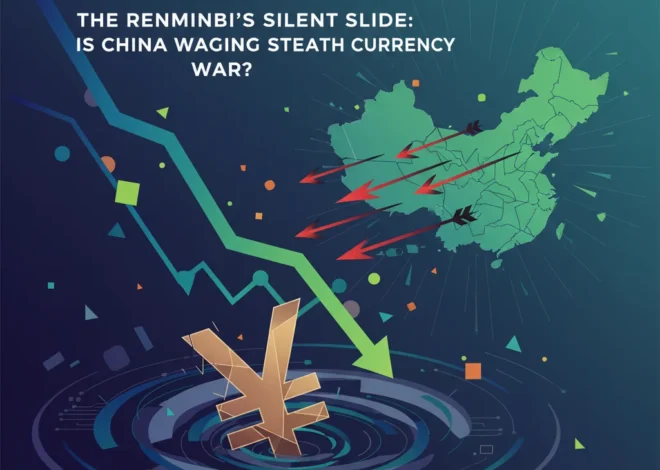
Beyond the Dollar: Decoding China’s Strategy to Reshape Global Finance
For decades, the U.S. dollar has been the undisputed king of global finance. It’s the currency of international trade, the primary reserve held by central banks, and the safe haven investors flock to in times of crisis. But a seismic shift is quietly underway, and its epicenter is in Beijing. China is accelerating a multi-decade campaign to elevate its currency, the renminbi (RMB), on the world stage—a move that could fundamentally reshape the landscape of the global economy.
Recent data reveals a dramatic surge in overseas lending denominated in renminbi, a clear signal of China’s intent. This isn’t just about national pride; it’s a calculated geopolitical and economic strategy to reduce reliance on the U.S. dollar and build a new, multi-polar monetary system. For investors, business leaders, and anyone involved in global finance, understanding this trend is no longer optional—it’s essential for navigating the future.
The Unquestioned Reign of the Dollar: A Brief History
To appreciate the magnitude of China’s ambition, we must first understand the dollar’s dominance. Established in the aftermath of World War II with the Bretton Woods Agreement, the U.S. dollar was pegged to gold, and other currencies were pegged to the dollar. Though the gold standard was abandoned in 1971, the dollar’s supremacy persisted. Why? Three key reasons:
- Deep, Liquid Markets: The U.S. boasts the world’s largest and most liquid financial markets, making it easy to buy and sell dollar-denominated assets.
- Geopolitical Stability: Despite its challenges, the U.S. has long been viewed as a politically stable nation with strong institutions and respect for the rule of law.
- Inertia and Network Effects: The global financial system, from the SWIFT banking network to commodity trading, is built on dollar-based plumbing. The more people use it, the more useful it becomes, creating a powerful self-reinforcing cycle.
This “exorbitant privilege,” as it’s often called, allows the U.S. to borrow cheaply and exert significant influence through financial sanctions. It’s this very influence that is now fueling the push for alternatives.
Cracks in the Foundation: The Rise of De-Dollarization
The term “de-dollarization” has moved from the fringes of economics forums to the headlines of major financial publications. The primary catalyst has been the increasing use of the dollar-centric financial system as a tool of foreign policy. When the U.S. imposes sanctions, it can effectively cut off countries from the global financial system, a powerful weapon that has prompted nations like Russia, Iran, and increasingly, China, to seek alternatives.
Beijing’s push is the most significant. Analysts point to a concerted effort to build a parallel financial ecosystem, one where the renminbi plays a central role. According to a report from the Financial Times, overseas renminbi lending by Chinese banks has surged, indicating a clear policy directive to promote the currency in international trade and investment.
India's AI Gold Rush: Is Google's Infrastructure Bet Outpacing Governance?
China’s Playbook: A Multi-Pronged Strategy for RMB Internationalization
China is not just waiting for the dollar to decline; it is actively building the infrastructure for a renminbi-centric world. This strategy involves several key pillars:
1. The Belt and Road Initiative (BRI) as a Financial Artery
The BRI, China’s massive global infrastructure project, is more than just roads and ports; it’s a financial artery for the renminbi. By providing loans for these projects in its own currency, China creates a natural demand for the RMB. Recipient countries use the renminbi to pay Chinese contractors, and as these economies become more intertwined with China’s, they are more likely to use the RMB for bilateral trade.
2. Dominating Commodity Trading
A key pillar of the dollar’s strength is its use in pricing and trading global commodities, particularly oil (the “petrodollar” system). China, as the world’s largest commodity importer, is chipping away at this dominance. It has launched renminbi-denominated futures contracts for crude oil and is increasingly settling commodity trades with partners like Russia and Saudi Arabia directly in RMB. This “petroyuan” strategy is a direct challenge to the dollar’s core function.
3. The Fintech and Blockchain Frontier
China is a leader in financial technology, and it’s leveraging this advantage. The development of its Central Bank Digital Currency (CBDC), the e-CNY or digital yuan, is a game-changer. While still in its early stages for cross-border use, a digital renminbi could eventually allow for international transactions that bypass the SWIFT network entirely. This fintech innovation offers a more efficient and state-controlled alternative to the dollar-based system, which is particularly appealing to other nations wary of U.S. oversight.
While the renminbi’s global footprint is growing, it’s important to keep its current scale in perspective. The dollar remains overwhelmingly dominant. However, the trendline is clear, as shown by data on the renminbi’s share of global payments.
| Year | Global Rank | Share of Global Payments |
|---|---|---|
| 2014 | #7 | 1.59% (source) |
| 2021 | #5 | 2.70% |
| Late 2023 | #4 | 4.61% (source) |
This data illustrates a slow but undeniable increase in the renminbi’s usage, overtaking the Japanese yen to become the fourth most-used currency for global payments.
The £3,000 Scoop: What an Ice Cream Shop's Bill Reveals About the UK Economy
The Long Road Ahead: Hurdles on the Path to Dominance
Despite China’s determined push, the renminbi faces significant obstacles on its path to dethroning the dollar. These challenges are structural and will not be overcome easily:
- Capital Controls: As mentioned, Beijing’s tight grip on capital flows prevents the RMB from being fully convertible. Global investors need assurance they can move their money freely, a guarantee China is not yet willing to provide.
- Lack of Trust and Transparency: The rule of law, transparency of regulatory bodies, and the independence of the judiciary are cornerstones of a reserve currency’s appeal. China’s state-controlled system does not inspire the same level of confidence as the U.S. system.
- Absence of Deep, Liquid Markets: While China’s domestic stock market and bond markets are large, they are not as open or accessible to international investors as their U.S. counterparts.
- No Allies for a Reserve Currency: The U.S. dollar is supported by a deep network of allies with convertible currencies (Euro, Yen, Pound). China lacks a similar network of economically powerful allies willing to hold vast reserves of RMB.
What This Means for You: Navigating a New Financial World
The gradual shift away from a unipolar, dollar-dominated world has profound implications for every participant in the global economy.
For Investors:
The rise of the renminbi creates both risks and opportunities. Currency diversification will become increasingly important in portfolio management. Investing directly in Chinese assets, such as the A-shares market or government bonds, could offer growth potential, but comes with significant political and regulatory risk. Watching the RMB/USD exchange rate will be crucial for anyone involved in international trading.
For Businesses:
Companies with global supply chains may see more contracts invoiced in renminbi, particularly when dealing with Chinese partners or countries within the BRI’s sphere of influence. This introduces new currency risks that must be hedged. It also opens up new avenues for trade finance directly through Chinese banking institutions.
For the Global Economy:
A multi-polar currency system could be more volatile in the short term as the world adjusts. It may lead to the formation of distinct financial blocs, one centered around the dollar and its allies, and another around the renminbi and its partners. This fragmentation could challenge global institutions and create new geopolitical friction points. However, it could also offer emerging markets more choice and reduce their vulnerability to U.S. monetary policy swings.
Conclusion: An Evolution, Not a Revolution
The U.S. dollar is not going to be replaced overnight. Its dominance is deeply entrenched in the global financial architecture. However, China’s determined campaign to promote the renminbi is undeniably accelerating a long-term shift towards a more multi-polar currency world. The surge in overseas RMB lending is not an isolated event; it’s a key piece of a larger strategic puzzle.
This evolution from a dollar-based to a multi-currency system will be one of the defining stories in finance and economics for the coming decades. Ignoring it is not an option. For those who understand the forces at play, this new era will present a wealth of opportunities; for those who don’t, it will be fraught with risk.


